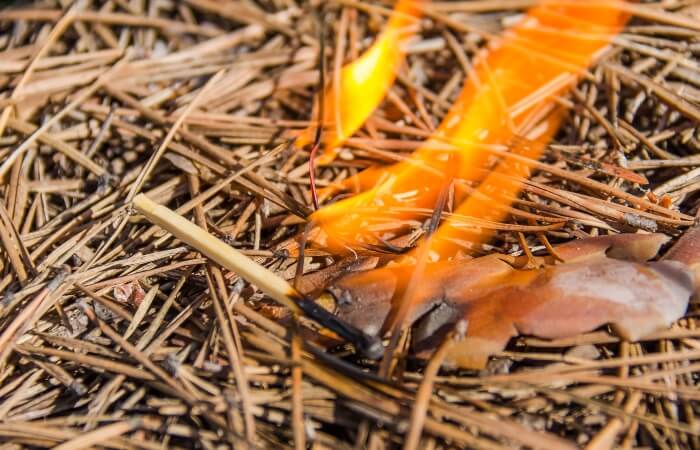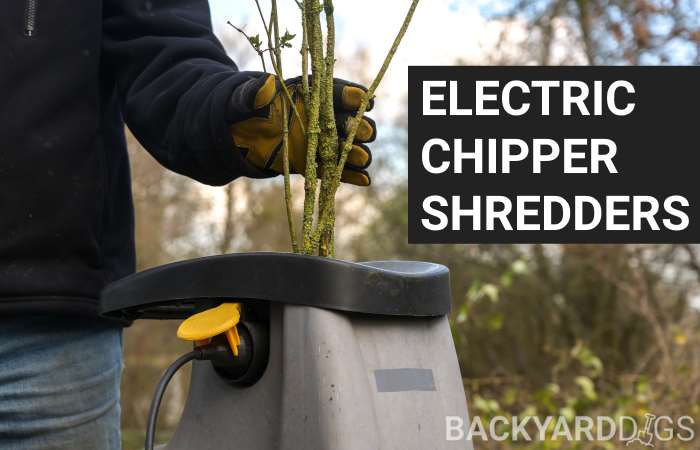Do you have excess pine needles in your yard and wonder if you can burn them safely?
The answer depends on where you live and local laws and policies on open burns. Even when permitted, using proper precautions and equipment to prevent wildfires or harmful smoke inhalation is a must. However, I always recommend composting pine needles or bagging them for disposal instead of burning whenever possible.

To learn if it’s poisonous to burn pine needles and the best way to discard large piles of pine straw using fire, you only need to keep reading. I put all the details below on the safest way to burn pine needles, so you can keep your yard looking neat!
Is Burning Pine Needles Poisonous?
While many species of pine trees have needles that can be toxic to consume, burning the needles is not shown to be poisonous to humans.
Smoke from any fire can irritate the mouth, throat, and lung tissues, so it’s wise to avoid directly inhaling smoke from pine needle fires.
Alkaloids are common in plants, including pine trees.
A research study by the Pacific Northwest National Laboratory in Washington shows microscopic particles of nearly 100 different alkaloids in the smoke from lab-made forest fire simulations.
What impact these alkaloids have on the toxicity to humans and animals has yet to be determined.
Another study by Environmental Health Perspectives shows that smoldering pine needles and wood have a high mutagenic effect, which means the smoke has the potential to be more carcinogenic versus the impact of burning of other organic material.
Limiting exposure to the smoke from pine needles fires is best to avoid any long-term damage from any poisonous particles floating from the embers.
Can You Burn Green Pine Needles?
You can burn both dried and green pine needles. However, the green needles will create more smoke due to the higher moisture content, so try to limit the number of fresh needles you add to the pile to reduce smoke.
Before you start your fire, make sure you have a water source (hose or filled buckets) nearby to douse flames quickly and a metal rake and shovel to keep any loose burning pine straw contained.
A good size for a burn pile is about four feet wide and several feet tall. Pine needles will burn up quickly and intensely, then settle down to hot embers that will take a bit longer to burn off.
Make a clearing at least ten feet around the burn pile, and don’t forget to check overhead for branches from nearby trees that could catch on fire.
Best Way To Burn Pine Needles
The number one problem caused by burning pine needles is the potential of igniting a forest or structural fire. The quick-burning pine straw can easily blow embers into the woods or spread across the ground if you don’t create a fire break.
Before you have any outdoor fires, you should call the local fire department or county office to check for burn bans or restrictions on what material you’re allowed to burn. You’ll also need to check with your insurance company to verify you will be covered incase of an accident.
You may need to contain your pine needles inside a fire pit or grating to prevent material from blowing. However, you don’t want to get a fine for not following local burn guidelines.
Also, check the weather, as you never want to burn yard waste on windy days. A good rule is to burn needles two or three days after rain since the ground should still be damp or when humidity levels are above 30%.
Once you have the all-clear to burn pine needles, the best way to start is by raking the straw into piles far from any structures and clearing the ground of loose matter to avoid accidental spread.
Do not create a burn pile near any roadways, as the smoke could interfere with the safe visibility of drivers.
Igniting The Pine Needles
Again, before you start any fires, you should always check with your local by-laws and fire codes for burning within city limits. Keep a fire extinguisher and water hose on hand to put out any fires that get out of hand.
When you ignite your pine needles, avoid using accelerants like gasoline or lighter fluid, or it can quickly flame up and catch bystanders unaware.
The best course is to use crumpled newspaper as a base underneath the pine needle pile and start the paper with the long-handled lighter. The slower burn of the paper will allow you to step back and have a rake ready to control the fire as it builds.
As the bulk of the pine needles begin to burn down, you can use a garden fork to add more pine needles to the top of the fire until you work through all your yard waste.
You want to add pine needles a few forkfuls at a time. Adding too much on top will cut off oxygen flow, and the fire will begin to smolder and cause excessive smoke.
Never leave the pile unattended once you start it on fire. You must monitor the height of the flames, as well as watch for any blowing embers you’ll need to put out.
After you burn all your pine needles, you’ll want to ensure no heat is left in the pile before you walk away.
Using a metal rake, move the ashes back and forth inside the fire pit until you don’t see any more red embers, flames, or smoke. Douse the material with water and rake the material around some more.
You can also shovel dirt over all the material once it cools down.
Don’t just bury hot pine needles ashes under a layer of dirt. The dirt will insulate the embers and give them a chance to flare up again.
Check the soil and ashes for heat after several hours to ensure there are no chances of reignition.
In Summary
Pine needles can make a mess in your yard, and burning them is a quick and efficient way to dispose of them if local laws allow open burns.
If you can’t recycle pine needles for mulch or use them in compost, burning them may be your best solution.










